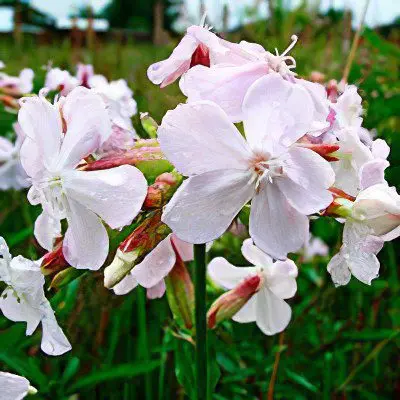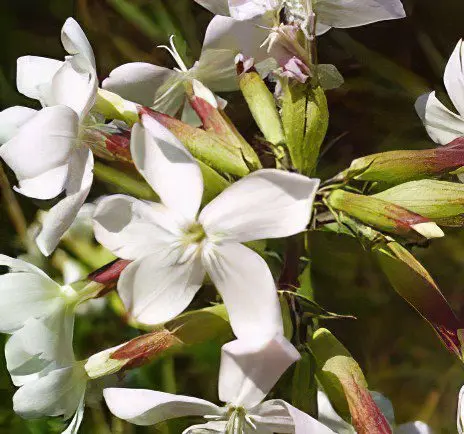Contents
Useful properties and application of soapwort officinalis
Botanical characteristics of soapwort

Mylnianka is a herbaceous plant in the form of a flower, which belongs to the clove family. The plant has a powerful root system, spreading with long reddish-brown roots. On straight bare stems are the leaves of the plant, tapering at the base, they are located on short petioles, opposite. The flowers of this medicinal plant are white or pale pink in color, they are collected in panicle inflorescences. The fruit of the soapwort is a box with seeds. The plant blooms from early summer to early autumn.
The soapwort can be seen in the Caucasus, Southern Europe, Western Siberia and Central Europe. It grows on the edge of the forest, near residential buildings, in valleys, on the banks of rivers, in fields and meadows. In many countries, it is cultivated for decorative and medicinal purposes.
Soapwort cultivation
If favorable conditions are created for the soapwort, then it can grow in one place for about 8 years. Soapweed is a plant that loves the sun and dry soil. The plant does not tolerate excess nitrogen, this must be taken into account when planting it. The soil for planting soapwort should be moderately loose and fertilized. Mylnyanka grows well in the crevices of stones.
The soapwort should be planted in the form of a small seedling with a clod of earth, since an adult plant does not tolerate transplantation due to its strong branching.
When the soapwort fades, you need to cut the plant by a third – this is necessary to give a beautiful and compact shape to the bush. In addition, thanks to pruning, the plant will be able to branch out more intensively and protect itself from self-seeding. For the winter, some types of soapwort are pruned.
Useful properties of soapwort
There are nine species of this perennial herbaceous plant. They are wild, they are also grown as ornamental crops. The medicinal value is the root, called the red soap root, which contains saponins, and in particular triterpene saponins, saponazides A, B, C and D. The leaves are saturated with saponarozide, saponarin glycoside and ascorbic acid. Triterpene saponins are soapy substances, and therefore decoctions of the root foam and are used as soap for washing animals and washing woolen fabrics. This excellent expectorant exhibits diaphoretic, diuretic and choleretic properties. For constipation, it is effective as a laxative.
The use of soapwort

Soapwort contains ascorbic acid, glycosides and saponins, due to which it is used for bronchitis and cough. Soapwort has diuretic and laxative properties, which is why it is added to collections that purify the blood. And also the plant is used as an excellent diaphoretic.
Soapwort is used for jaundice, respiratory diseases, joint pain and metabolic disorders. This plant is used in the form of infusions and decoctions. In diseases of the spleen or liver, a decoction of the soapwort root is used.
Soapwort is used in the form of baths, powder, ointments and lotions for scabies, eczema, furunculosis, dermatitis and skin rashes. People who cannot get rid of scaly lichen in any way can use a preparation from soapwort.
Decoction of saponaria roots for the treatment of eczema and liver diseases. You need to take 10 grams of the roots of the plant and pour 250 ml of boiling water over them, and then leave the composition on fire for 5 minutes. After straining, the decoction can be used 100 ml three times a day. Also, this decoction can be used for gargling with sore throat.
Soap tea. You need to take 1 teaspoon of soapwort (roots and grass), pour them with a glass of boiling water and leave to infuse for 3 hours. Next, bring the resulting broth to its original volume by adding boiled water. In the presence of a cough, take 2 glasses of this tea. And if you dilute this decoction with chamomile tea, you can make compresses or washing.
Collection of herbs for nausea and bloating. To prepare it, you need to take 5 grams of soapwort roots, 3 grams of celandine and 10 grams of St. John’s wort. Now pour 1 tablespoon of this collection with 1 glass of boiling water and insist for half an hour. Ready broth take no more than three glasses a day. The same collection helps in the treatment of gallstone disease.
In folk medicine, rhizomes and roots of soapwort are used for gas formation in the gastrointestinal tract. Decoctions and infusions treat rheumatism and gout, as well as various skin diseases such as eczema, psoriasis, and furunculosis. Infusion from furunculosis: 1 teaspoon of chopped rhizome is poured with a glass of boiling water, infused for 4 hours and consumed 3 times a day, 2 tablespoons after meals.
With the help of an infusion of grass, sexually transmitted diseases are overcome. For external use, lotions, baths, ointments and mushy mixtures are used. Scabies, purulent wounds, scrofula lesions, various dermatitis and erysipelas are sprinkled with soap powder. Aqueous extracts from the aerial part of the soapwort and roots are good for whooping cough, debilitating cough with bronchitis. Grass softens breathing and eliminates wheezing, which are observed in patients with colds.
In folk medicine, the leaves of the plant are also used; their collection is best done during the flowering period. Leaf infusions normalize metabolism, cleanse the skin. The diuretic properties of the herb are used to treat dropsy and edema associated with diseases of the kidneys and liver.
The strong choleretic properties of the plant can be used in the presence of infectious diseases. Means from soapwort cope with stones in the gallbladder, soften and gently remove them along with toxins. Soapwort is toxic, it should be used for short courses and only after consulting a doctor.
soapwort root
Roots and rhizomes are harvested in late autumn and stored in linen or fabric bags. A decoction of rhizomes is used for rheumatism, chronic hepatitis, cholecystitis, diseases of the intestines and stomach. An amazing plant is effective in diseases of the spleen, accompanied by nausea, constipation and excessive bloating, it relieves heartburn well.
Before starting the process of preparing a decoction or infusion, you need to cut the roots as small as possible, soak in water for 5-6 hours, periodically draining the foam, then dry it – and you can prepare the drug. If the medicinal roots are planned to be used for an expectorant effect, then they do not need to be soaked and the foam drained, but the recipe should be used immediately.
Decoction of soapwort: 6 g of the root must be boiled in a glass of water and taken 1 tablespoon 3-4 times a day. This recipe is used if necessary to eliminate edema and cleanse the kidneys.
If you chew the root with a toothache, it subsides or is eliminated altogether. With angina, it is useful to use the infusion as a rinse, for washing the nose during a cold.
soapwort extract

Saponaria extract is a product extracted from a plant containing, in addition to saponins, flavonol glycosides. The miraculous remedy exhibits anti-inflammatory and antifungal properties, acts as a body purifier of harmful toxins, and improves metabolism.
The organic extract tends to foam, so it is included in shampoos and dishwashing detergents that have a pleasant herbal aroma. They are safe for people with sensitive skin and prone to allergic diseases. In addition, the extract regulates the oil balance of the skin.
Soapy drug
This perennial of the clove family, 30–90 cm high, is popularly known by many names. This species has numerous long, creeping, reddish-brown roots, branched stems and white flowers with a delicate smell. Grass in nature chooses water meadows, forest edges, lives in abandoned wastelands. In France, it is used as an insecticide, used in gastronomy for the preparation of halva, carbonated drinks.
Mylianca basilifolia
Saponaria basilica can grow in one place for about 6–8 years. It decorates gardens with pillows up to 20 cm tall and abundant flowering. Pink flowers look beautiful against the background of various herbaceous ground cover plants. It’s good to have a live pharmacy close at hand. Many gardeners grow this species in order to improve their health and treat many diseases. It is useful to drink decoctions in reasonable doses in acute catarrhs of the stomach and intestines, after operations on the intestinal tract.
Decoction of soapwort: 30 grams of raw materials should be boiled for 5 minutes in 1 liter of boiling water and consumed in equal doses all day with hepatitis.
Common soapwort
Common soapwort is a medicinal soap herb. Nature has given a lot of knowledge about this plant, it has been valued for many centuries and is now used in scientific and folk medicine. A perennial herbaceous plant has a straight trunk 30–90 centimeters high, sometimes naked or pubescent with woolly hairs. The rhizome of the plant is creeping, branched, red-brown. This type of soapwort blooms from early June to September. Its aroma is especially pronounced in the evening.
Under natural conditions, the common soapwort grows in the southern regions of Russia, spreading along the plains of rivers, edges, thickets of shrubs. This species can be seen in Western Europe, Asia and the Caucasus.
Infusion of rhizomes: 1 tablespoon of crushed raw materials must be infused in 250 ml of cold boiled water and divided into parts so that it is enough for several doses for the whole day. It is recommended to drink the remedy in small sips for bronchitis.
Contraindications to the use of soapwort
From an arbitrary overdose of the drug, nausea, vomiting, acute abdominal pain and diarrhea, cough can be observed. This is because saponins have a local irritant effect. In such cases, treatment with soapwort cannot be continued. When preparing decoctions, remember that all parts of the herb are poisonous. A sign of poisoning is a sweetish-burning taste in the mouth and a feeling of mucus formation.
It is recommended to wash the stomach and take funds with enveloping properties. All procedures during the collection of the plant must be carried out in protective equipment to protect the respiratory tract and eyes from small particles of raw materials.









